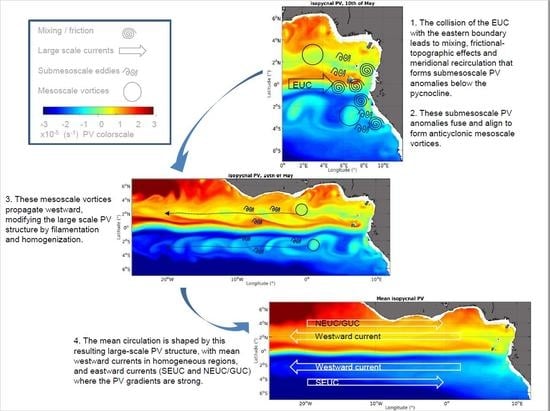From Mixing to the Large Scale Circulation: How the Inverse Cascade Is Involved in the Formation of the Subsurface Currents in the Gulf of Guinea
Abstract
1. Introduction
2. Model, Configuration and Diagnostics
2.1. The Tropical Atlantic NEMO Configuration
2.2. Potential Vorticity Diagnostics
3. Results
3.1. Mean Zonal Subsurface Currents in the Equatorial Band
3.2. Mean Zonal Currents and PV Fields
3.3. High Frequency Mesoscale Circulation
3.3.1. Analysis of Vortical Structures
3.3.2. Evolution of the Mesoscale Field
3.4. Mechanisms for the Generation of PV Anomalies and Vortices
- adiabatic effects associated with meridional advection of particles within a varying background potential vorticity gradient (planetary effect and mean currents PV structure);
- mixing in boundary layers or within the water-column, mostly associated with strong vertical shear;
- frictional effects associated with surface wind or bottom drag, or lateral boundaries, in the case of vertical walls (which is the case when geopotential coordinates are used, such as in the NEMO model).
3.4.1. Advection
3.4.2. Mixing
3.4.3. Friction
3.5. Lagrangian Analysis
3.5.1. Tracking Algorithm
3.5.2. Lagrangian Diagnostics
- Particles for which the initial and final PV value remain similar ( s−1), identified with ⋄ on the following plots.
- Particles characterized by relatively high initial PV values which undergo a strong decrease during their evolution (), identified with +.
- Particles characterized by relatively weak initial PV values which undergo a sharp increase during their evolution (), identified with ◃.
4. Summary, Discussion and Perspectives
4.1. Summary
4.2. Discussion
- meridional advection was mentioned in [20,118,119,120,121] and in particular in [122] who associated it with transport by nonlinear eddies. Lateral diffusion of vorticity from the EUC, generated by horizontal diffusion, was also the mechanism proposed in [123] and was interpreted as representing meridional advection of PV by mesoscale eddies;
4.3. Perspectives
Supplementary Materials
Author Contributions
Funding
Acknowledgments
Conflicts of Interest
Abbreviations
| EUC | Equatorial Undercurrent |
| NEUC | North Equatorial Undercurrent |
| SEUC | South Equatorial Undercurrent |
| GUC | Guinea Undercurrent |
| SEC | South Equatorial Current |
| NEC | North Equatorial Current |
References
- Stramma, L.; Schott, F. The mean flow field of the tropical Atlantic Ocean. Deep. Sea Res. Part ii Top. Stud. Oceanogr. 1999, 46, 279–303. [Google Scholar] [CrossRef]
- Blanke, B.; Arhan, M.; Madec, G.; Roche, S. Warm water paths in the equatorial Atlantic as diagnosed with a general circulation model. J. Phys. Oceanogr. 1999, 29, 2753–2768. [Google Scholar] [CrossRef]
- Hazeleger, W.; de Vries, P.; Friocourt, Y. Sources of the Equatorial Undercurrent in the Atlantic in a High-Resolution Ocean Model. J. Phys. Oceanogr. 2003, 33, 677–693. [Google Scholar] [CrossRef]
- Hazeleger, W.; de Vries, P. Fate of the Equatorial Undercurrent in the Atlantic. In Interhemispheric Water Exchange in the Atlantic Ocean; Elsevier Oceanography Series; Goni, G., Malanotte-Rizzoli, P., Eds.; Elsevier: Amsterdam, The Netherlands, 2003; Volume 68, pp. 175–191. [Google Scholar] [CrossRef]
- Brandt, P.; Hormann, V.; Bourlès, B.; Fischer, J.; Schott, F.A.; Stramma, L.; Dengler, M. Oxygen tongues and zonal currents in the equatorial Atlantic. J. Geophys. Res. Ocean. 2008, 113. [Google Scholar] [CrossRef]
- Marin, F.; Caniaux, G.; Giordani, H.; Bourlès, B.; Gouriou, Y.; Key, E. Why Were Sea Surface Temperatures so Different in the Eastern Equatorial Atlantic in June 2005 and 2006? J. Phys. Oceanogr. 2009, 39, 1416–1431. [Google Scholar] [CrossRef]
- Brandt, P.; Hormann, V.; Körtzinger, A.; Visbeck, M.; Krahmann, G.; Stramma, L.; Lumpkin, R.; Schmid, C. Changes in the Ventilation of the Oxygen Minimum Zone of the Tropical North Atlantic. J. Phys. Oceanogr. 2010, 40, 1784–1801. [Google Scholar] [CrossRef]
- Bourlès, B.; Lumpkin, R.; McPhaden, M.J.; Hernandez, F.; Nobre, P.; Campos, E.; Yu, L.; Planton, S.; Busalacchi, A.; Moura, A.D.; et al. THE PIRATA PROGRAM: History, Accomplishments, and Future Directions. Bull. Am. Meteorol. Soc. 2008, 89, 1111–1126. [Google Scholar] [CrossRef]
- Bourlès, B.; Araujo, M.; McPhaden, M.J.; Brandt, P.; Foltz, G.R.; Lumpkin, R.; Giordani, H.; Hernandez, F.; Lefèvre, N.; Nobre, P.; et al. PIRATA: A Sustained Observing System for Tropical Atlantic Climate Research and Forecasting. Earth Space Sci. 2019, 6, 577–616. [Google Scholar] [CrossRef]
- Gouriou, Y.; Reverdin, G. Isopycnal and diapycnal circulation of the upper equatorial Atlantic Ocean in 1983–1984. J. Geophys. Res. Ocean. 1992, 97, 3543–3572. [Google Scholar] [CrossRef]
- Bourlès, B.; D’Orgeville, M.; Eldin, G.; Gouriou, Y.; Chuchla, R.; DuPenhoat, Y.; Arnault, S. On the evolution of the thermocline and subthermocline eastward currents in the Equatorial Atlantic. Geophys. Res. Lett. 2002, 29, 32-1–32-4. [Google Scholar] [CrossRef]
- Fischer, J.; Hormann, V.; Brandt, P.; Schott, F.A.; Rabe, B.; Funk, A. South Equatorial Undercurrent in the western to central tropical Atlantic. Geophys. Res. Lett. 2008, 35. [Google Scholar] [CrossRef]
- Kolodziejczyk, N.; Bourlès, B.; Marin, F.; Grelet, J.; Chuchla, R. Seasonal variability of the Equatorial Undercurrent at 10° W as inferred from recent in situ observations. J. Geophys. Res. Ocean. 2009, 114. [Google Scholar] [CrossRef]
- Kolodziejczyk, N.; Marin, F.; Bourlès, B.; Gouriou, Y.; Berger, H. Seasonal variability of the equatorial undercurrent termination and associated salinity maximum in the Gulf of Guinea. Clim. Dyn. 2014, 43, 3025–3046. [Google Scholar] [CrossRef]
- Visbeck, M.; Araujo, M.; Boetius, A.; Buch, E.; Claustre, H.; Dabrowski, T.; Delory, E.; de Young, B.; Ken, F.; Albert, F.; et al. More integrated and more sustainable Atlantic ocean observing (AtlantOS). Clivar Exch. 2015, 67, 18–20. [Google Scholar]
- Foltz, G.R.; Brandt, P.; Richter, I.; Rodríguez-Fonseca, B.; Hernandez, F.; Dengler, M.; Rodrigues, R.R.; Schmidt, J.O.; Yu, L.; Lefevre, N.; et al. The Tropical Atlantic Observing System. Front. Mar. Sci. 2019, 6, 206. [Google Scholar] [CrossRef]
- Tsuchiya, M. Thermostats and circulation in the upper layer of the Atlantic Ocean. Prog. Oceanogr. 1986, 16, 235–267. [Google Scholar] [CrossRef]
- Schott, F.A.; Mccreary, J.P., Jr.; Johnson, G.C. Shallow Overturning Circulations of the Tropical-Subtropical Oceans. In Earth’s Climate; American Geophysical Union (AGU): Washington, DC, USA, 2004; pp. 261–304. [Google Scholar] [CrossRef]
- Schott, F.A.; Fischer, J.; Stramma, L. Transports and Pathways of the Upper-Layer Circulation in the Western Tropical Atlantic. J. Phys. Oceanogr. 1998, 28, 1904–1928. [Google Scholar] [CrossRef]
- Wang, C. Subthermocline tropical cells and equatorial subsurface countercurrents. Deep. Sea Res. Part Oceanogr. Res. Pap. 2005, 52, 123–135. [Google Scholar] [CrossRef]
- Huttl-Kabus, S.; Boning, C.W. Pathways and variability of the off-equatorial undercurrents in the Atlantic Ocean. J. Geophys. Res. Ocean. 2008, 113. [Google Scholar] [CrossRef]
- Jochum, M.; Malanotte-Rizzoli, P. A New Theory for the Generation of the Equatorial Subsurface Countercurrents. J. Phys. Oceanogr. 2004, 34, 755–771. [Google Scholar] [CrossRef][Green Version]
- Greatbatch, R.J.; Claus, M.; Brandt, P.; Matthiesen, J.D.; Tuchen, F.P.; Ascani, F.; Dengler, M.; Toole, J.; Roth, C.; Farrar, J.T. Evidence for the Maintenance of Slowly Varying Equatorial Currents by Intraseasonal Variability. Geophys. Res. Lett. 2018, 45, 1923–1929. [Google Scholar] [CrossRef]
- Herbert, G.; Bourlès, B.; Penven, P.; Grelet, J. New insights on the upper layer circulation north of the Gulf of Guinea. J. Geophys. Res. Ocean. 2016, 121, 6793–6815. [Google Scholar] [CrossRef]
- Verstraete, J.M. The seasonal upwellings in the Gulf of Guinea. Prog. Oceanogr. 1992, 29, 1–60. [Google Scholar] [CrossRef]
- Weatherall, P.; Marks, K.M.; Jakobsson, M.; Schmitt, T.; Tani, S.; Arndt, J.E.; Rovere, M.; Chayes, D.; Ferrini, V.; Wigley, R. A new digital bathymetric model of the world’s oceans. Earth Space Sci. 2015, 2, 331–345. [Google Scholar] [CrossRef]
- Madec, G.; The NEMO Team. NEMO Ocean Engine; Institut Pierre-Simon Laplace (IPSL): Paris, France, 2016; pp. 1288–1619. [Google Scholar]
- Blayo, E.; Debreu, L. Adaptive mesh refinement for finite difference ocean models: First experiments. J. Phys. Oceanogr. 1999, 32, 1239–1250. [Google Scholar] [CrossRef]
- Debreu, L. Raffinement Adaptatif de Maillage et Méthode de Zoom. Application Aux Modèles D’oceéan. Ph.D. Thesis, Université Joseph Fourier, Grenoble, France, 2000. [Google Scholar]
- Webb, D.J.; Cuevas, B.D.; Richmond, C. Improved advection schemes for ocean models. J. Atmos. Ocean Tech. 1998, 15, 1171–1187. [Google Scholar] [CrossRef]
- Leclair, M.; Madec, G. A conservative leap-frog time stepping method. Ocean Model. 2009, 30, 88–94. [Google Scholar] [CrossRef]
- Blanke, B.; Delecluse, P. Variability of the tropical Atlantic Ocean simulated by a general circulation model with two different mixed layer physics. J. Phys. Oceanogr. 1993, 23, 1363–1388. [Google Scholar] [CrossRef]
- Ferry, N.; Parent, L.; Garric, G.; Bricaud, C.; Testut, C.; Le Galloudec, O.; Lellouche, J.; Drevillon, M.; Greiner, E.; Barnier, B.; et al. GLORYS2V1 Global Ocean Reanalysis of the Altimetric Era (1992–2009) at Meso Scale. Mercat. Ocean. Quaterly Newsl. 2012, 44, 29–39. [Google Scholar]
- Large, W.G.; Yeager, S. The global climatology of an interan- nually varying air–sea flux data set. Clim. Dynam. 2009, 33, 341–364. [Google Scholar] [CrossRef]
- Dussin, R.; Barnier, B.; Brodeau, L.; Molines, J.M. The Making of the Drakkar Forcing Set DFS5; DRAKKAR/MyOcean Report 01-04-16; Laboratoire de glaciologie et géophysique de l’environnement (LGGE): Grenoble, France, 2016. [Google Scholar]
- Dee, D.P.; Uppala, S.M.; Simmons, A.J.; Berrisford, P.; Poli, P.; Kobayashi, S.; Andrae, U.; Balmaseda, M.A.; Balsamo, G.; Bauer, P.; et al. The ERA-Interim reanalysis: Configuration and performance of the data assimilation system. Q. J. R. Meteorol. Soc. 2011, 137, 553–597. [Google Scholar] [CrossRef]
- Dai, A.; Trenberth, K. Estimates of freshwater discharge from continents: Latitudinal and seasonal variations. J. Hydrometeor. 2002, 3, 660–687. [Google Scholar] [CrossRef]
- Jouanno, J.; Hernandez, O.; Sanchez-Gomez, E. Equatorial Atlantic interannual variability and its relation to dynamic and thermodynamic processes. Earth Syst. Dynam. 2017, 8, 1061–1069. [Google Scholar] [CrossRef]
- Lübbecke, J.F.; Rodríguez-Fonseca, B.; Richter, I.; Martín-Rey, M.; Losada, T.; Polo, I.; Keenlyside, N.S. Equatorial Atlantic variability—Modes, mechanisms, and global teleconnections. WIREs Clim. Chang. 2018, 9, e527. [Google Scholar] [CrossRef]
- Hernandez, O.; Jouanno, J.; Echevin, V.; Aumont, O. Impacts of chlorophyll concentrations on the Tropical Atlantic Ocean. J. Geophys. Res. Oceans 2017. [Google Scholar] [CrossRef]
- Da-Allada, C.Y.; Jouanno, J.; Gaillard, F.; Kolodziejczyk, N.; Maes, C.; Reul, N.; Bourles, B. Importance of the Equatorial Undercurrent on the Sea Surface Salinity in the Eastern Equatorial Atlantic in boreal spring. J. Geophys. Res. Oceans 2017, 122. [Google Scholar] [CrossRef]
- Hoskins, B.J.; McIntyre, M.E.; Robertson, A.W. On the use and significance of isentropic potential vorticity maps. Q. J. R. Met. Soc. 1985, 470, 877–946. [Google Scholar] [CrossRef]
- Rowe, G.D.; Firing, E.; Johnson, G.C. Pacific equatorial subsurface countercurrent velocity, transport, and potential vorticity. J. Phys. Oceanogr. 2000, 30, 1172–1187. [Google Scholar] [CrossRef]
- Cravatte, S.; Kestenare, E.; Marin, F.; Dutrieux, P.; Firing, E. Subthermocline and Intermediate Zonal Currents in the Tropical Pacific Ocean: Paths and Vertical Structure. J. Phys. Oceanogr. 2017, 47, 2305–2324. [Google Scholar] [CrossRef]
- Delpech, A.; Cravatte, S.; Marin, F.; Morel, Y.; Gronchi, E.; Kestenare, E. Observed Tracer Fields Structuration by Middepth Zonal Jets in the Tropical Pacific. J. Phys. Oceanogr. 2020, 50, 281–304. [Google Scholar] [CrossRef]
- Ertel, H. On hydrodynamic eddy theorems. Phys. Z. 1942, 43, 526–529. [Google Scholar]
- Muller, P. The Equations of Oceanic Motions; Cambridge University Press: Cambridge, UK, 2006. [Google Scholar]
- Morel, Y.; Gula, J.; Ponte, A. Potential vorticity diagnostics based on balances between volume integral and boundary conditions. Ocean. Model. 2019, 138, 23–35. [Google Scholar] [CrossRef]
- Morel, Y.; McWilliams, J. Effects of isopycnal and diapycnal mixing on the stability of Ocean ic currents. J. Phys. Ocean. 2001, 31, 2280–2296. [Google Scholar] [CrossRef]
- Herbette, S.; Morel, Y.; Arhan, M. Erosion of a surface vortex by a seamount. J. Phys. Oceanogr. 2003, 33, 1664–1679. [Google Scholar] [CrossRef]
- Herbette, S.; Morel, Y.; Arhan, M. Erosion of a surface vortex by a seamount on the beta plane. J. Phys. Oceanogr. 2005, 35, 2012–2030. [Google Scholar] [CrossRef]
- Morel, Y.; Thomas, L. Ekman drift and vortical structures. Ocean Modell. 2009, 27, 185–197. [Google Scholar] [CrossRef]
- Bachèlery, M.L.; Illig, S.; Dadou, I. Interannual variability in the South-East Atlantic Ocean, focusing on the Benguela Upwelling System: Remote versus local forcing. J. Geophys. Res. Ocean. 2016, 121, 284–310. [Google Scholar] [CrossRef]
- Brandt, P.; Funk, A.; Tantet, A.; Johns, W.E.; Fischer, J. The Equatorial Undercurrent in the central Atlantic and its relation to tropical Atlantic variability. Clim. Dyn. 2014, 43, 2985–2997. [Google Scholar] [CrossRef]
- Johns, W.E.; Brandt, P.; Bourlès, B.; Tantet, A.; Papapostolou, A.; Houk, A. Zonal structure and seasonal variability of the Atlantic Equatorial Undercurrent. Clim. Dyn. 2014, 43, 3047–3069. [Google Scholar] [CrossRef]
- Burmeister, K.; Luebbecke, J.F.; Brandt, P.; Claus, M.; Hahn, J. Fluctuations of the Atlantic North Equatorial Undercurrent and Associated Changes in Oxygen Transports. Geophys. Res. Lett. 2020, 47, e2020GL088350. [Google Scholar] [CrossRef]
- Rosell-Fieschi, M.; Pelegrí, J.L.; Gourrion, J. Zonal jets in the equatorial Atlantic Ocean. Prog. Oceanogr. 2015, 130, 1–18. [Google Scholar] [CrossRef]
- Richardson, P.L.; Reverdin, G. Seasonal cycle of velocity in the Atlantic North Equatorial Countercurrent as measured by surface drifters, current meters, and ship drifts. J. Geophys. Res. Ocean. 1987, 92, 3691–3708. [Google Scholar] [CrossRef]
- Richardson, P.L.; Arnault, S.; Garzoli, S.; Bruce, J.G. Annual cycle of the Atlantic North Equatorial Countercurrent. Deep Sea Res. Part Oceanogr. Res. Pap. 1992, 39, 997–1014. [Google Scholar] [CrossRef]
- Brandt, P.; Eden, C. Annual cycle and interannual variability of the mid-depth tropical Atlantic Ocean. Deep Sea Res. Part Oceanogr. Res. Pap. 2005, 52, 199–219. [Google Scholar] [CrossRef]
- Carton, J.A.; Zhou, Z. Annual cycle of sea surface temperature in the tropical Atlantic Ocean. J. Geophys. Res. Ocean. 1997, 102, 27813–27824. [Google Scholar] [CrossRef]
- Caniaux, G.; Giordani, H.; Redelsperger, J.L.; Guichard, F.; Key, E.; Wade, M. Coupling between the Atlantic cold tongue and the West African monsoon in boreal spring and summer. J. Geophys. Res. Ocean. 2011, 116. [Google Scholar] [CrossRef]
- McIntyre, M.E.; Norton, W. Potential Vorticity Inversion on a Hemisphere. J. Atmos. Sci. 2000, 57, 1214–1235. [Google Scholar] [CrossRef]
- Cushman-Roisin, B.; Beckers, J.M. Introduction to Geophysical Fluid Dynamics; Academic Press: Cambridge, MA, USA, 2011; 875p. [Google Scholar]
- Gregg, M.; Peters, H.; Wesson, J.; Oakey, N.; Shay, T. Intensive measurements of turbulence and shear in the equatorial undercurrent. Nature 1985, 318, 140–144. [Google Scholar] [CrossRef]
- Hummels, R.; Dengler, M.; Bourlès, B. Seasonal and regional variability of upper ocean diapycnal heat flux in the Atlantic cold tongue. Prog. Oceanogr. 2013, 111, 52–74. [Google Scholar] [CrossRef]
- Da-Allada, C.Y.; du Penhoat, Y.; Jouanno, J.; Alory, G.; Hounkonnou, N.M. Modeled mixed-layer salinity balance in the Gulf of Guinea: Seasonal and interannual variability. Ocean. Dyn. 2014, 64, 1783–1802. [Google Scholar] [CrossRef]
- Aguedjou, H.M.A.; Dadou, I.; Chaigneau, A.; Morel, Y.; Alory, G. Eddies in the Tropical Atlantic Ocean and Their Seasonal Variability. Geophys. Res. Lett. 2019, 46, 12156–12164. [Google Scholar] [CrossRef]
- Chelton, D.B.; Schlax, M.G.; Samelson, R.M. Global observations of nonlinear mesoscale eddies. Prog. Oceanogr. 2011, 91, 167–216. [Google Scholar] [CrossRef]
- McWilliams, J.; Flierl, G. Evolution of isolated, nonlinear vortices. J. Phys. Oceanogr. 1979, 9, 1155–1182. [Google Scholar] [CrossRef]
- Sutyrin, G.; Flierl, G. Intense vortex motion on the beta-plane - Development of the beta-gyres. J. Atmos. Sci. 1994, 51, 773–790. [Google Scholar] [CrossRef]
- Sutyrin, G.; Morel, Y. Intense vortex motion in a stratified fluid on the beta-plane. An analytical model and its validation. J. Fluid Mech. 1997, 336, 203–220. [Google Scholar] [CrossRef]
- Morel, Y.; McWilliams, J. Evolution of isolated interior vortices in the Ocean. J. Phys. Ocean. 1997, 27, 727–748. [Google Scholar] [CrossRef]
- Vandermeirsch, F.; Carton, X.; Morel, Y. Interaction between an eddy and a zonal jet—Part I. One-and-a-half-layer model. Dyn. Atmos. Ocean. 2003, 36, 247–270. [Google Scholar] [CrossRef]
- Vandermeirsch, F.; Carton, X.; Morel, Y. Interaction between an eddy and a zonal jet—Part II. Two-and-a-half-layer model. Dyn. Atmos. Ocean. 2003, 36, 271–296. [Google Scholar] [CrossRef]
- Sutyrin, G.; Carton, X. Vortex interaction with a zonal Rossby wave in a quasi-geostrophic model. Dyn. Atmos. Ocean. 2006, 41, 85–102. [Google Scholar] [CrossRef]
- Vandermeirsch, F.; Morel, Y.; Sutyrin, G. The net advective effect of a vertically sheared current on a coherent vortex. J. Phys. Ocean Oceanogr. 2001, 31, 2210–2225. [Google Scholar] [CrossRef]
- Rhines, P.B. Waves and turbulence on a beta-plane. J. Fluid Mech. 1975, 69, 417–443. [Google Scholar] [CrossRef]
- Rhines, P.; Young, W. Homogenization of potential vorticity in planetary gyres. J. Fluid Mech. 1982, 122, 347–367. [Google Scholar] [CrossRef]
- Rhines, P.; Young, W. A Theory of the Wind-Driven Circulation. I, Mid-Ocean Gyres. J. Mar. Res. 1982, 40, 559–596. [Google Scholar]
- Rhines, P. Vorticity dynamics of the Ocean in general circulation. Annu. Rev. Fluid Mech. 1986, 18, 433–497. [Google Scholar] [CrossRef]
- Vallis, G.K.; Maltrud, M.E. Generation of Mean Flows and Jets on a Beta Plane and over Topography. J. Phys. Oceanogr. 1993, 23, 1346–1362. [Google Scholar] [CrossRef]
- Danilov, S.; Gryanik, V.M. Barotropic beta-plane turbulence in a regime with strong zonal jets revisited. J. Atmos. Sci. 2004, 61, 2283–2295. [Google Scholar] [CrossRef]
- Thompson, A.F.; Young, W.R. Two-layer baroclinic eddy heat fluxes: Zonal flows and energy balance. J. Atmos. Sci. 2007, 64, 3214–3231. [Google Scholar] [CrossRef]
- Srinivasan, K.; Young, W. Zonostrophic instability. J. Atmos. Sci. 2012, 69, 1633–1656. [Google Scholar] [CrossRef]
- Dritschel, D.; McIntyre, M. Multiple jets as PV staircases: The Phillips effect and the resilience of eddy-transport barriers. J. Atmos. Sci. 2008, 65, 855–874. [Google Scholar] [CrossRef]
- Dritschel, D.; Scott, R. Jet sharpening by turbulent mixing. Philos. Trans. R. Soc. Lond. Math. Phys. Eng. Sci. 2011, 369, 754–770. [Google Scholar] [CrossRef]
- Meunier, T.; Ménesguen, C.; Schopp, R.; Le Gentil, S. Tracer Stirring around a Meddy: The Formation of Layering. J. Phys. Oceanogr. 2015, 45, 407–423. [Google Scholar] [CrossRef]
- Haynes, P.; McIntyre, M. On the evolution of vorticity and potential vorticity in the presence of diabatic heating and frictional or other forces. J. Atmos. Sci. 1987, 44, 828–841. [Google Scholar] [CrossRef]
- Haynes, P.; McIntyre, M. On the conservation and impermeability theorems for potential vorticity. J. Atmos. Sci. 1990, 47, 2021–2031. [Google Scholar] [CrossRef]
- Thomas, L.N. Destruction of Potential Vorticity by Winds. J. Phys. Oceanogr. 2005, 35, 2457–2466. [Google Scholar] [CrossRef]
- Morel, Y.; Darr, D.; Tailandier, C. Possible sources driving the potential vorticity structure and long-wave instability of coastal upwelling and downwelling currents. J. Phys. Ocean. 2006, 36, 875–896. [Google Scholar] [CrossRef]
- Benthuysen, J.; Thomas, L. Friction and Diapycnal Mixing at a Slope: Boundary Control of Potential Vorticity. J. Phys. Oceanogr. 2012, 42, 1509–1523. [Google Scholar] [CrossRef]
- Gula, J.; Molemaker, M.; McWilliams, J. Topographic vorticity generation, submesoscale instability and vortex street formation in the Gulf Stream. Geophys. Res. Lett. 2015, 42, 4054–4062. [Google Scholar] [CrossRef]
- Gula, J.; Molemaker, M.; McWilliams, J. Topographic generation of submesoscale centrifugal instability and energy dissipation. Nat. Commun. 2016, 7, 12811. [Google Scholar] [CrossRef]
- Holmes, R.M.; Thomas, L.N.; Thompson, L.; Darr, D. Potential Vorticity Dynamics of Tropical Instability Vortices. J. Phys. Oceanogr. 2014, 44, 995–1011. [Google Scholar] [CrossRef]
- Holmes, R.M.; Thomas, L.N. Modulation of Tropical Instability Wave Intensity by Equatorial Kelvin Waves. J. Phys. Oceanogr. 2016, 46, 2623–2643. [Google Scholar] [CrossRef]
- D’Asaro, E. Generation of submesoscale vortices: A new mechanism. J. Geophys. Res. Ocean. 1988, 93-C6, 2156–2202. [Google Scholar] [CrossRef]
- Akuetevi, C.Q.C.; Wirth, A. Dynamics of turbulent western-boundary currents at low latitude in a shallow-water model. Ocean. Sci. 2015, 11, 471–481. [Google Scholar] [CrossRef]
- Thomas, L.N. Formation of intrathermocline eddies at ocean fronts by wind-driven destruction of potential vorticity. Dyn. Atmos. Ocean. 2008, 45, 252–273. [Google Scholar] [CrossRef]
- Thomas, L.; Ferrari, R. Friction, Frontogenesis, and the Stratification of the Surface Mixed Layer. J. Phys. Oceanogr. 2008, 38, 2501–2518. [Google Scholar] [CrossRef]
- Wenegrat, J.O.; Thomas, L.N.; Gula, J.; McWilliams, J.C. Effects of the Submesoscale on the Potential Vorticity Budget of Ocean Mode Waters. J. Phys. Oceanogr. 2018, 48, 2141–2165. [Google Scholar] [CrossRef]
- Gula, J.; Blacic, T.M.; Todd, R.E. Submesoscale Coherent Vortices in the Gulf Stream. Geophys. Res. Lett. 2019, 46. [Google Scholar] [CrossRef]
- van Sebille, E.; Griffies, S.M.; Abernathey, R.; Adams, T.P.; Berloff, P.; Biastoch, A.; Blanke, B.; Chassignet, E.P.; Cheng, Y.; Cotter, C.J.; et al. Lagrangian ocean analysis: Fundamentals and practices. Ocean. Model. 2018, 121, 49–75. [Google Scholar] [CrossRef]
- Hua, B.L. The conservation of potential vorticity along Lagrangian trajectories in simulations of eddy-driven flows. J. Phys. Oceanogr. 1994, 24, 498–508. [Google Scholar] [CrossRef]
- Cui, W.; Wang, W.; Zhang, J.; Yang, J. Multicore structures and the splitting and merging of eddies in global oceans from satellite altimeter data. Ocean. Sci. 2019, 15, 413–430. [Google Scholar] [CrossRef]
- de Marez, C.; Carton, X.; L’Hégaret, P.; Meunier, T.; Stegner, A.; Le Vu, B.; Morvan, M. Oceanic vortex mergers are not isolated but influenced by the beta-effect and surrounding eddies. Sci. Rep. 2020, 10, 2897. [Google Scholar] [CrossRef]
- Schultz Tokos, K.L.; Hinrichsen, H.H.; Zenk, W. Merging and Migration of Two Meddies. J. Phys. Oceanogr. 1994, 24, 2129–2141. [Google Scholar] [CrossRef]
- Ménesguen, C.; Delpech, A.; Marin, F.; Cravatte, S.; Schopp, R.; Morel, Y. Observations and Mechanisms for the Formation of Deep Equatorial and Tropical Circulation. Earth Space Sci. 2019, 6, 370–386. [Google Scholar] [CrossRef]
- Stommel, H. Is the South Pacific helium-3 plume dynamically active? Earth Planet. Sci. Lett. 1982, 61, 63–67. [Google Scholar] [CrossRef]
- Rhines, P.B. Jets. Chaos 1994, 4, 313–339. [Google Scholar] [CrossRef] [PubMed]
- Özgökmen, T.M.; Crisciani, F. On the Dynamics of beta Plumes. J. Phys. Oceanogr. 2001, 31, 3569–3580. [Google Scholar] [CrossRef]
- McCreary, J.P.; Lu, P.; Yu, Z. Dynamics of the Pacific subsurface countercurrents. J. Phys. Oceanogr. 2002, 32, 2379–2404. [Google Scholar] [CrossRef]
- Furue, R.; McCreary, J.P., Jr.; Yu, Z.; Wang, D. Dynamics of the southern Tsuchiya Jet. J. Phys. Oceanogr. 2007, 37, 531–553. [Google Scholar] [CrossRef]
- Furue, R.; McCreary, J.P., Jr.; Yu, Z. Dynamics of the northern Tsuchiya Jet. J. Phys. Oceanogr. 2009, 39, 2024–2051. [Google Scholar] [CrossRef]
- Belmadani, A.; Maximenko, N.A.; Mccreary, J.P.; Furue, R.; Melnichenko, O.V.; Schneider, N.; Lorenzo, E.D. Linear Wind-Forced Beta Plumes with Application to the Hawaiian Lee Countercurrent. J. Phys. Oceanogr. 2013, 43, 2071–2094. [Google Scholar] [CrossRef]
- Davey, M.K.; Killworth, P.D. Flows Produced by Discrete Sources of Buoyancy. J. Phys. Oceanogr. 1989, 19, 1279–1290. [Google Scholar] [CrossRef]
- Johnson, G.C.; Moore, D.W. The Pacific Subsurface Countercurrents and an Inertial Model. J. Phys. Oceanogr. 1997, 27, 2448–2459. [Google Scholar] [CrossRef]
- Marin, F.; Hua, B.L.; Wacongne, S. The equatorial thermostad and subsurface countercurrents in the light of the dynamics of atmospheric Hadley cells. J. Mar. Res. 2000, 58, 405–437. [Google Scholar] [CrossRef]
- Hua, B.L.; Marin, F.; Schopp, R. Three-dimensional dynamics of the subsurface countercurrents and equatorial thermostad. Part I: Formulation of the problem and generic properties. J. Phys. Oceanogr. 2003, 33, 2588–2609. [Google Scholar] [CrossRef]
- Marin, F.; Schopp, R.; Hua, B.L. Three-dimensional dynamics of the subsurface countercurrents and equatorial thermostad. Part II: Influence of the large-scale ventilation and of equatorial winds. J. Phys. Oceanogr. 2003, 33, 2610–2626. [Google Scholar] [CrossRef]
- Ishida, A.; Mitsudera, H.; Kashino, Y.; Kadokura, T. Equatorial Pacific subsurface countercurrents in a high-resolution global ocean circulation model. J. Geophys. Res. Ocean. 2005, 110. [Google Scholar] [CrossRef]
- McPhaden, M.J. On the Dynamics of Equatorial Subsurface Countercurrents. J. Phys. Oceanogr. 1984, 14, 1216–1225. [Google Scholar] [CrossRef][Green Version]
- Delpech, A.; Cravatte, S.; Marin, F.; Ménesguen, C.; Morel, Y. Deep Eddy Kinetic Energy in the Tropical Pacific from Lagrangian Floats. J. Geophys. Res. Ocean. 2020, 125. [Google Scholar] [CrossRef]
- Charney, J.; Stern, M. On the stability of internal baroclinic jets in a rotating atmosphere. J. Atmos. Sci. 1962, 19, 159–172. [Google Scholar] [CrossRef]
- Pichon, A.; Morel, Y.; Baraille, R.; Quaresma, L. Internal tide interactions in the Bay of Biscay: Observations and modelling. J. Mar. Syst. 2013, 109–110, S26–S44. [Google Scholar] [CrossRef]
- Holmes, R.M.; Zika, J.D.; England, M.H. Diathermal Heat Transport in a Global Ocean Model. J. Phys. Oceanogr. 2018, 49, 141–161. [Google Scholar] [CrossRef]
- Lübbecke, J.F.; Brandt, P.; Dengler, M.; Kopte, R.; Lüdke, J.; Richter, I.; Sena Martins, M.; Tchipalanga, P.C.M. Causes and evolution of the southeastern tropical Atlantic warm event in early 2016. Clim. Dyn. 2019, 53, 261–274. [Google Scholar] [CrossRef]





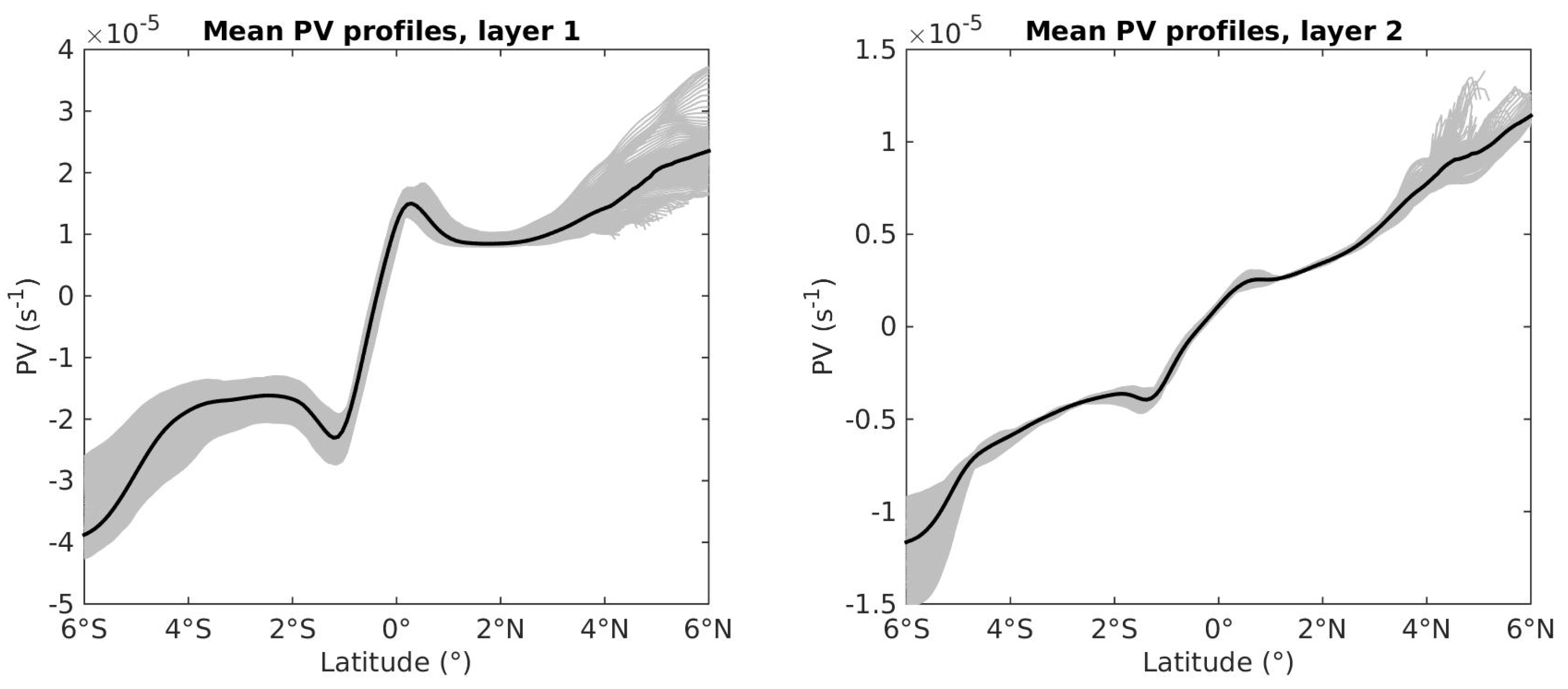
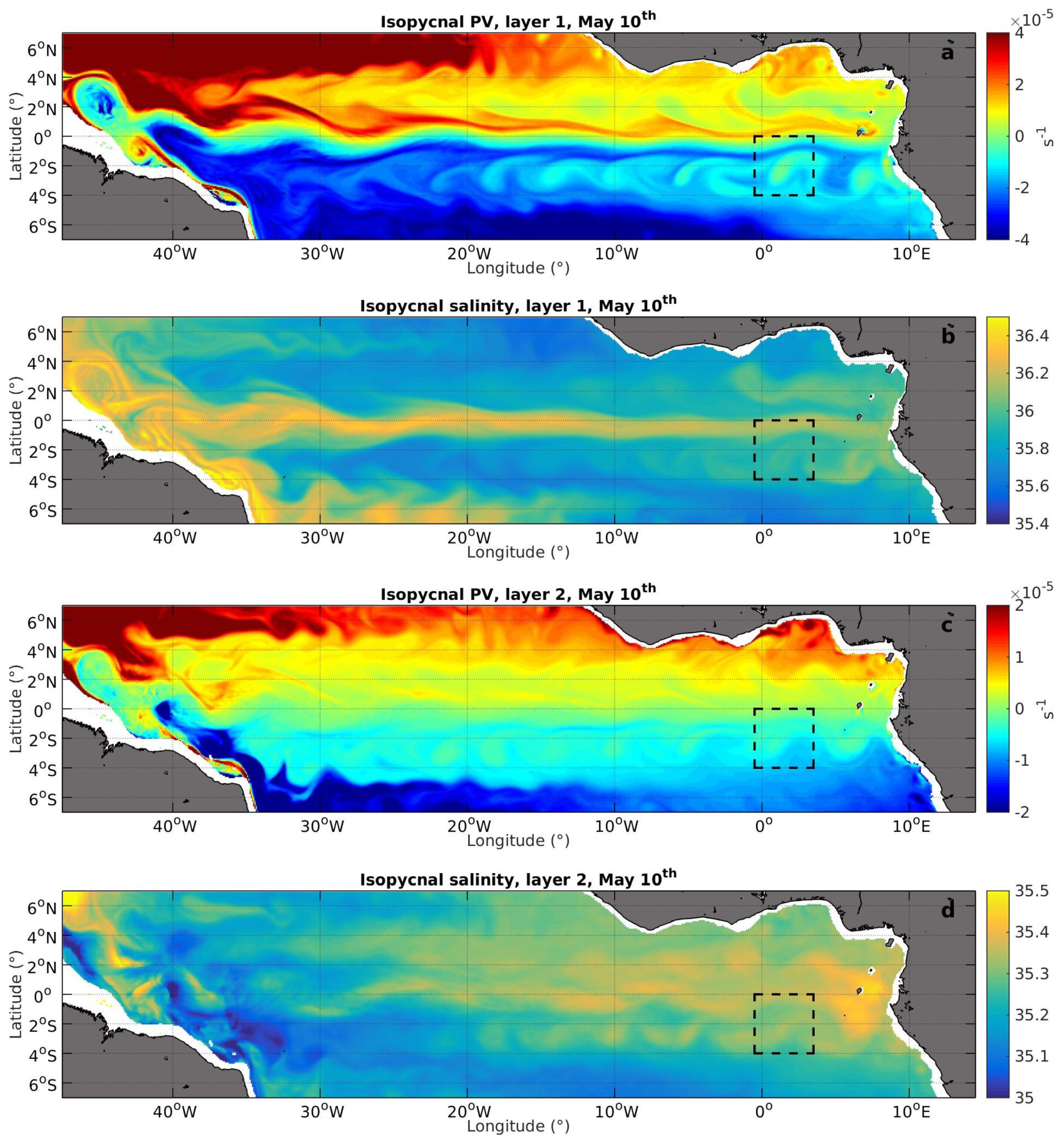


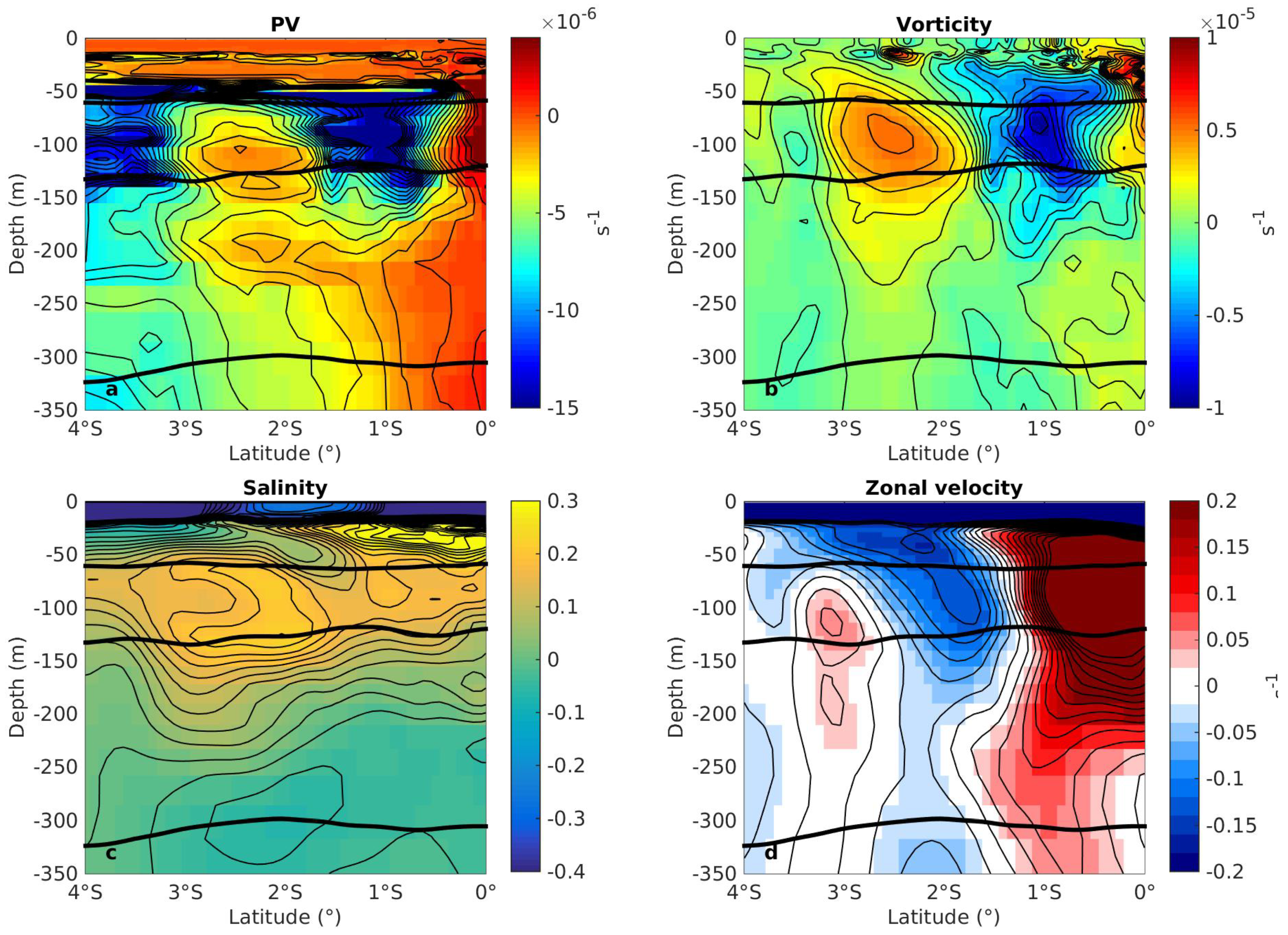





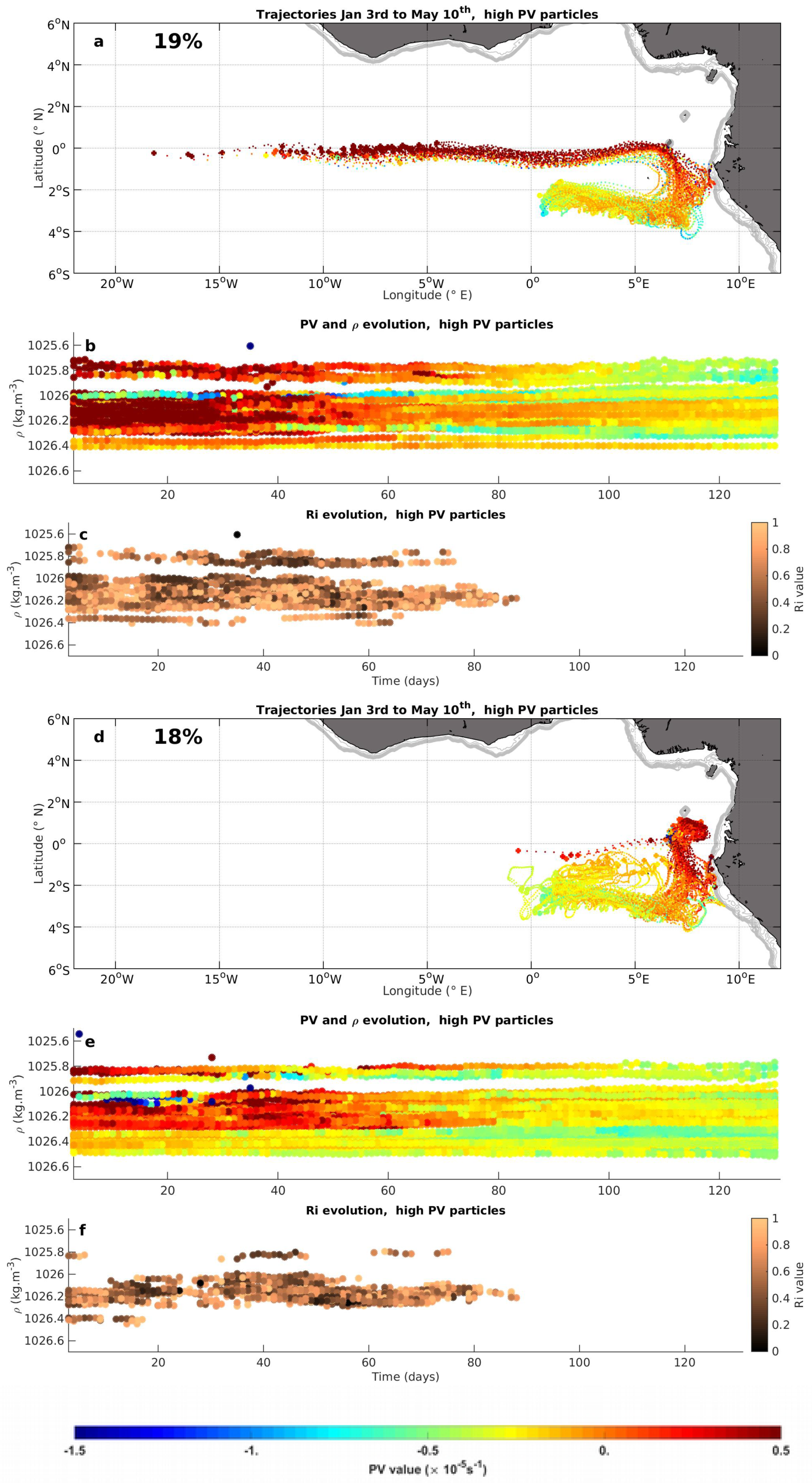


© 2020 by the authors. Licensee MDPI, Basel, Switzerland. This article is an open access article distributed under the terms and conditions of the Creative Commons Attribution (CC BY) license (http://creativecommons.org/licenses/by/4.0/).
Share and Cite
Assene, F.; Morel, Y.; Delpech, A.; Aguedjou, M.; Jouanno, J.; Cravatte, S.; Marin, F.; Ménesguen, C.; Chaigneau, A.; Dadou, I.; et al. From Mixing to the Large Scale Circulation: How the Inverse Cascade Is Involved in the Formation of the Subsurface Currents in the Gulf of Guinea. Fluids 2020, 5, 147. https://doi.org/10.3390/fluids5030147
Assene F, Morel Y, Delpech A, Aguedjou M, Jouanno J, Cravatte S, Marin F, Ménesguen C, Chaigneau A, Dadou I, et al. From Mixing to the Large Scale Circulation: How the Inverse Cascade Is Involved in the Formation of the Subsurface Currents in the Gulf of Guinea. Fluids. 2020; 5(3):147. https://doi.org/10.3390/fluids5030147
Chicago/Turabian StyleAssene, Fernand, Yves Morel, Audrey Delpech, Micael Aguedjou, Julien Jouanno, Sophie Cravatte, Frédéric Marin, Claire Ménesguen, Alexis Chaigneau, Isabelle Dadou, and et al. 2020. "From Mixing to the Large Scale Circulation: How the Inverse Cascade Is Involved in the Formation of the Subsurface Currents in the Gulf of Guinea" Fluids 5, no. 3: 147. https://doi.org/10.3390/fluids5030147
APA StyleAssene, F., Morel, Y., Delpech, A., Aguedjou, M., Jouanno, J., Cravatte, S., Marin, F., Ménesguen, C., Chaigneau, A., Dadou, I., Alory, G., Holmes, R., Bourlès, B., & Koch-Larrouy, A. (2020). From Mixing to the Large Scale Circulation: How the Inverse Cascade Is Involved in the Formation of the Subsurface Currents in the Gulf of Guinea. Fluids, 5(3), 147. https://doi.org/10.3390/fluids5030147





